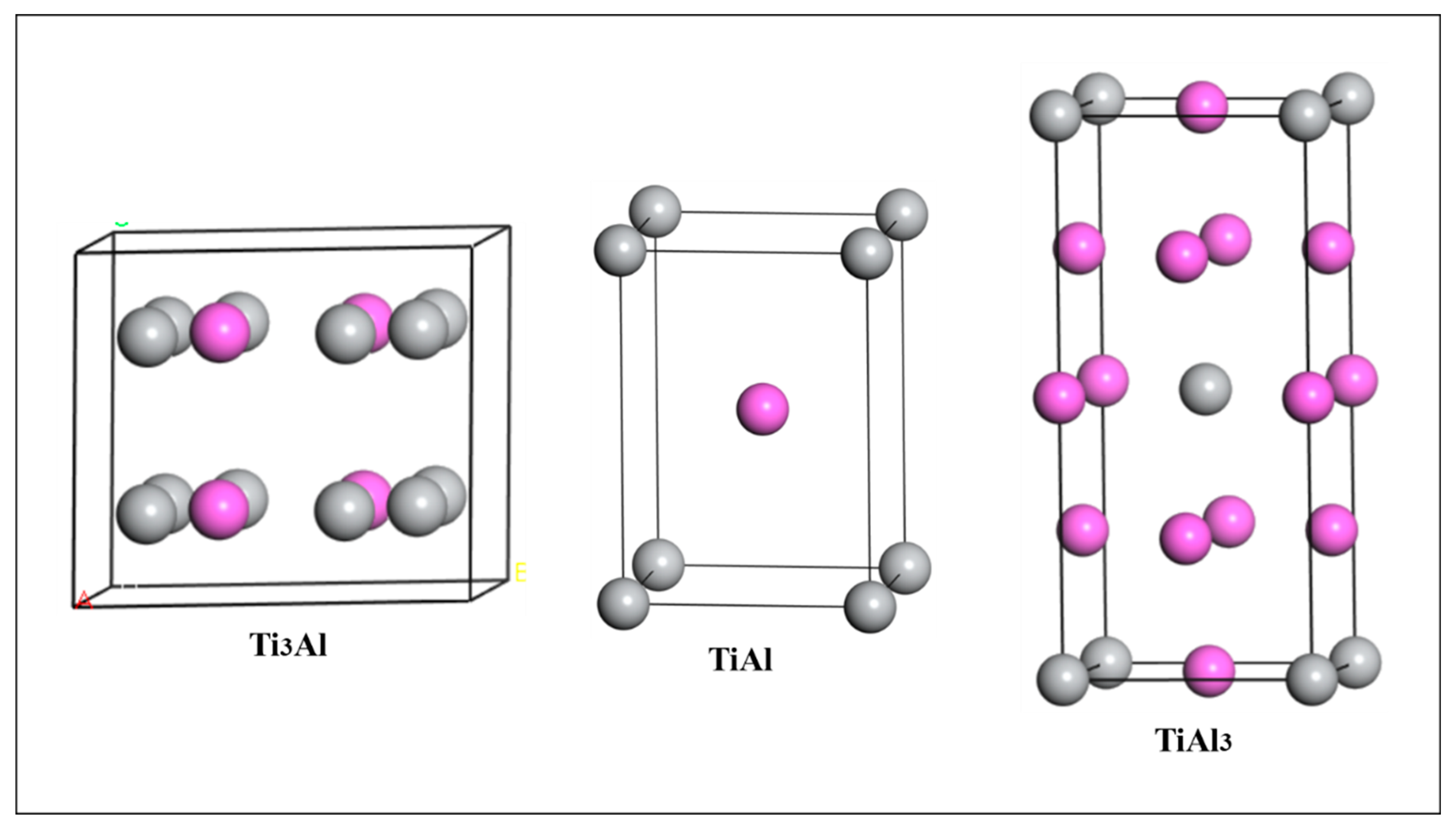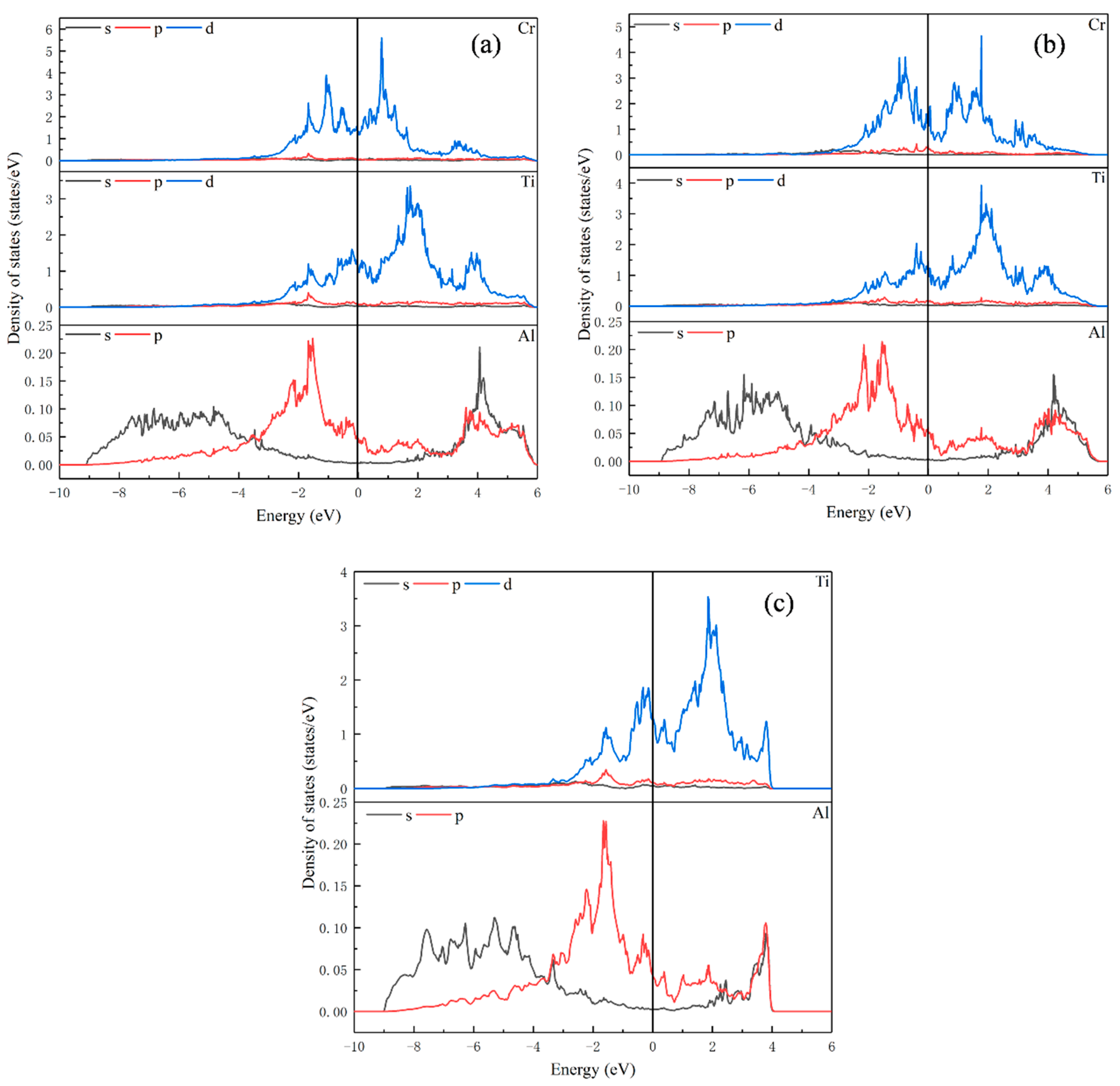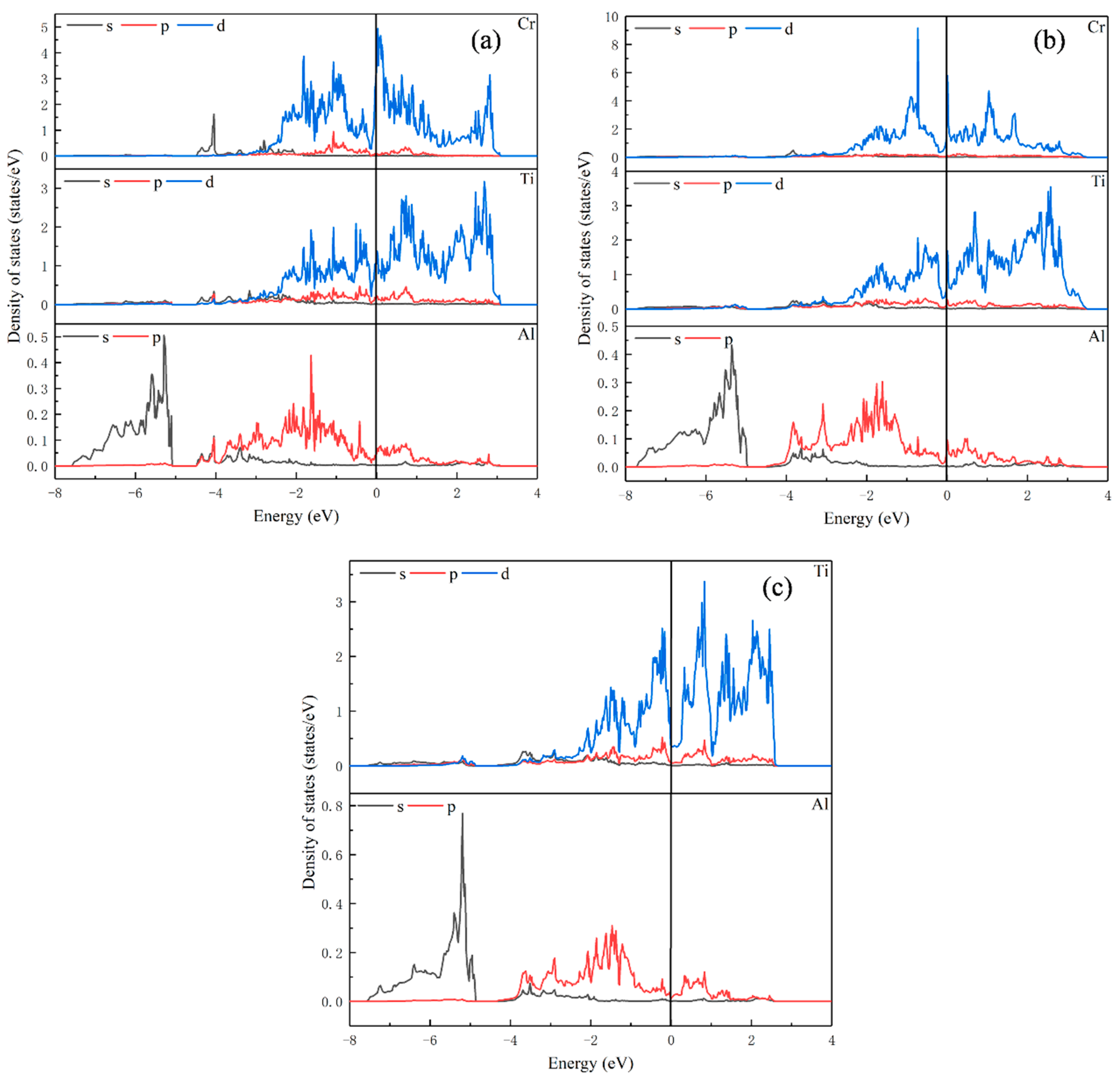The Effect of Cr Additive on the Mechanical Properties of Ti-Al Intermetallics by First-Principles Calculations
Abstract
1. Introduction
2. Calculation Method
3. Results and Discussion
4. Conclusions
- (1)
- The Cr atom prefers to replace Ti atoms in Ti-Al intermetallics. However, according to the formation energy and Born–Huang criterion, whether the Cr atom replaces Ti or Al, the system has energy stability and mechanical stability;
- (2)
- The ductility of TiAl and TiAl3 compounds cannot be improved by the Cr atom replacing the Ti atom but can be improved by the Cr atom replacing the Al atom. In the Ti3Al compound, the Cr atom can improve the ductility no matter whether it replaces Ti or Al, and the effect is better with the latter;
- (3)
- After replacing Al with Cr, the metal bond between Ti-Ti is strengthened, and a strong metal bond is formed between Cr and Ti, thus improving the ductility of Ti-Al intermetallics.
Author Contributions
Funding
Data Availability Statement
Conflicts of Interest
References
- Zhao, K.; Feng, N.; Wang, Y. Fabrication of Ti-Al intermetallics by a two-stage aluminothermic reduction process using Na2TiF6. Intermetallics 2017, 85, 156–162. [Google Scholar] [CrossRef]
- Song, Y.; Dou, Z.; Zhang, T.; Liu, Y.; Wang, G.C. First-principles calculation on the structural, elastic and thermodynamic properties of Ti-Al intermetallics. Mater. Res. Express 2019, 6, 1065. [Google Scholar] [CrossRef]
- Jian, Y.; Huang, Z.; Xing, J.; Sun, L.; Liu, Y.; Gao, P. Phase stability, mechanical properties and electronic structures of Ti Al binary compounds by first principles calculations. Mater. Chem. Phys. 2019, 221, 311–321. [Google Scholar] [CrossRef]
- Jiang, C. First-principles study of site occupancy of dilute 3d, 4d and 5d transition metal solutes in L10 TiAl. Acta. Mater. 2008, 56, 6224–6231. [Google Scholar] [CrossRef]
- Tang, P.; Tang, B.; Su, X. First-principles studies of typical long-period superstructures Al5Ti3, h-Al2Ti and r-Al2Ti in Al-rich TiAl alloys. Comput. Mater. Sci. 2011, 50, 1467–1476. [Google Scholar] [CrossRef]
- Zhang, L.G.Z.A. Ab initio pseudopotential calculations on the effect of Mn doped on lattice parameters of L10 TiAl. Intermetallics 2000, 8, 637–641. [Google Scholar]
- Song, Y.; Yang, R.; Li, D.; Hu, Z.Q.; Guo, Z.X. A first principles study of the influence of alloying elements on TiAl: Site preference. Intermetallics 2000, 8, 563–568. [Google Scholar] [CrossRef]
- Fan, T.; Lin, L.; Liang, H.; Ma, Y.; Tang, Y.; Hu, T.; Ruan, Z.; Chen, D.; Wu, Y. First-principles study of the structural, mechanical and thermodynamic properties of Al11RE3 in aluminum alloys. Crystals 2023, 13, 347. [Google Scholar] [CrossRef]
- Saraç, U.; Trong, D.N.; Baykul, M.C.; Long, V.C.; Ţălu, Ş. Tuning structural properties, morphology and magnetic characteristics of nanostructured Ni-Co-Fe/ITO ternary alloys by galvanostatic pretreatment process. Microsc. Res. Tech. 2022, 85, 3945–3954. [Google Scholar] [CrossRef]
- Qi, W.; Wang, W.; Yang, X.; Xie, L.; Zhang, J.; Li, D.; Zhang, Y. Effect of Zr on phase separation, mechanical and corrosion behavior of heterogeneous CoCrFeNiZrx high-entropy alloy. J. Mater. Sci. Technol. 2022, 109, 76–85. [Google Scholar] [CrossRef]
- Trong, D.N.; Long, V.C.; Tălu, Ş. The Structure and Crystallizing Process of NiAu Alloy: A Molecular Dynamics Simulation Method. J. Compos. Sci. 2021, 5, 18. [Google Scholar] [CrossRef]
- Couret, A.; Voisin, T.; Thomas, M.; Monchoux, J.P. Development of a TiAl Alloy by Spark Plasma Sintering. JOM 2017, 69, 2576–2582. [Google Scholar] [CrossRef]
- Tang, S.Q.; Qu, S.J.; Feng, A.H.; Shen, J.; Chen, D.L. Core-multishell globular oxidation in a new TiAlNbCr alloy at high temperatures. Sci. Rep. 2017, 7, 3483. [Google Scholar] [CrossRef]
- Kastenhuber, M.; Klein, T.; Clemens, H.; Mayer, S. Tailoring microstructure and chemical composition of advanced γ-TiAl based alloys for improved creep resistance. Intermetallics 2018, 97, 27–33. [Google Scholar] [CrossRef]
- Zhou, C.; Zeng, F.P.; Liu, B.; Zhao, K.; Lu, J.; Qiu, C.; Li, J.; He, Y. Effects of Si on Microstructures and High Temperature Properties of Beta Stabilized TiAl. Alloy. Mater. Trans. 2016, 57, 461–465. [Google Scholar] [CrossRef]
- Liu, Q.; Nash, P. The effect of Ruthenium addition on the microstructure and mechanical properties of TiAl alloys. Intermetallics 2011, 19, 1282–1290. [Google Scholar] [CrossRef]
- Tetsui, T. Effects of high niobium addition on the mechanical properties and high-temperature deformability of gamma TiAl alloy. Intermetallics 2002, 10, 239–245. [Google Scholar] [CrossRef]
- Liu, Z.C.; Lin, J.P.; Li, S.J.; Chen, G.L. Effects of Nb and Al on the microstructures and mechanical properties of high Nb containing TiAl base alloys. Intermetallics 2002, 10, 653–659. [Google Scholar] [CrossRef]
- Duan, Q.; Luan, Q.; Liu, J.; Peng, L. Microstructure and mechanical properties of directionally solidified high-Nb containing Ti–Al alloys. Mater. Des. 2010, 31, 3499–3503. [Google Scholar] [CrossRef]
- Music, D.; Schneider, J. Effect of transition metal additives on electronic structure and elastic properties of TiAl and Ti3Al. Phys. Rev. B 2006, 74, 174110. [Google Scholar] [CrossRef]
- Yuan, C.; Liu, B.; Liu, Y.X.; Yong, L.I.U. Processing map and hot deformation behavior of Ta-particle reinforced TiAl composite. T. Nonferr. Met. Soc. 2020, 30, 657–667. [Google Scholar] [CrossRef]
- Xiong, J.; Song, L.; Guo, X.; Liu, X.; Zhang, W.; Zhang, T. Inhibition of ω0 phase precipitation in TNM-based TiAl alloys by Cr and Mn. Intermetallics 2023, 153, 107774. [Google Scholar] [CrossRef]
- Ye, L.; Wang, H.; Zhou, G.; Hu, Q.M.; Yang, R. Phase stability of TiAl-X (X=V, Nb, Ta, Cr, Mo, W, and Mn) alloys. J. Alloys Compd. 2020, 819, 153291. [Google Scholar] [CrossRef]
- Tetsui, T. Impact resistance of commercially applied TiAl alloys and simple-composition TiAl alloys at various temperatures. Metals 2022, 12, 2003. [Google Scholar] [CrossRef]
- Fox-Rabinovich, G.S.; Weatherly, G.C.; Wilkinson, D.S.; Kovalev, A.I.; Wainstein, D.L. The role of chromium in protective alumina scale formation during the oxidation of ternary TiAlCr alloys in air. Intermetallics 2004, 12, 165–180. [Google Scholar] [CrossRef]
- Brady, M.P.; Wright, I.G.; Gleeson, B. Alloy design strategies for promoting protective oxide-scale formation. JOM 2000, 52, 16–21. [Google Scholar] [CrossRef]
- Kohn, W.; Sham, L.J. Self-Consistent Equations Including Exchange and Correlation Effects. Phys. Rev. 1965, 140, 1133–1141. [Google Scholar] [CrossRef]
- Kohn, W.; Hohenberg, P. Inhomogeneous Electron Gas. Phys. Rev. 1964, 136, 864–871. [Google Scholar]
- Kresse, G. Efficient iterative schemes for ab initio total-energy calculations using a plane-wave basis set. Phys. Rev. B 1996, 54, 11169–11186. [Google Scholar] [CrossRef]
- Kresse, G.; Furthmüller, J. Efficiency of ab-initio total energy calculations for metals and semiconductors using a plane-wave basis set. Comput. Mater. Sci. 1996, 6, 15–50. [Google Scholar] [CrossRef]
- Kresse, G.; Joubert, D. From ultrasoft pseudopotentials to the projector augmented-wave method. Phys. Rev. B 1999, 59, 1758–1775. [Google Scholar] [CrossRef]
- Blochl, P.E. Projector augmented-wave method. Phys. Rev. B 1994, 50, 17953–17979. [Google Scholar] [CrossRef]
- Perdew, J.P.; Burke, K.; Ernzerhof, M. Generalized Gradient Approximation Made Simple. Phys. Rev. Lett. 1996, 77, 3865–3868. [Google Scholar] [CrossRef] [PubMed]
- Tan, J.H.; Zhu, K.J.; Peng, J.H. First-principles simulation on structure property of Ti-Al intermetallics. J. Comput. Phys. 2017, 34, 365–373. [Google Scholar]
- Hultgren, R.; Desai, P.D.; Hawkins, D.T.; Gleiser, M.; Kelley, K.K. Selected values of the thermodynamic properties of binary alloys. Natl. Stand. Ref. Data Syst. 1973, 58, 1432. [Google Scholar]
- Xie, Y.; Tao, H.; Peng, H.; Li, X.; Liu, X.; Peng, K. Atomic states, potential energies, volumes, stability, and brittleness of ordered FCC TiAl3-type alloys. Phys. B Condens. Matter 2005, 366, 17–37. [Google Scholar] [CrossRef]
- Liu, Y.; Cui, X.; Niu, R.; Zhang, S.; Liao, X.; Moss, S.D.; Finkel, P.; Garbrecht, M.; Ringer, S.P.; Cairney, J.M.; et al. Giant room temperature compression and bending in ferroelectric oxide pillars. Nat. Commun. 2022, 13, 335. [Google Scholar] [CrossRef]




| Phase | Space Group | a/Å | b/Å | c/Å |
|---|---|---|---|---|
| Ti3Al | P63/mmc | 5.736 | 5.736 | 4.638 |
| P63/mmc | 5.70 a | 5.70 a | 4.616 a | |
| TiAl | P4/mmc | 2.815 | 2.815 | 4.071 |
| P4/mmc | 2.842 b | 2.842 b | 4.076 b | |
| 2.832 c | 2.832 c | 4.07 c | ||
| TiAl3 | I4/mmm | 3.842 | 3.842 | 8.609 |
| I4/mmm | 3.849 d | 3.849 d | 8.632 d | |
| 3.856 e | 3.856 e | 8.622 e |
| System | Site Occupancy | Etotal/eV | Ef/eV |
|---|---|---|---|
| Ti7Al24Cr | Ti | −165.315 | −11.687 |
| Ti8Al23Cr | Al | −168.919 | −11.271 |
| Ti15Al16Cr | Ti | −197.844 | −12.056 |
| Ti16Al15Cr | Al | −201.726 | −11.918 |
| Ti23Al8Cr | Ti | −226.189 | −8.241 |
| Ti24Al7Cr | Al | −228.869 | −6.901 |
| Phase | C11 | C22 | C33 | C44 | C55 | C66 | C12 | C13 | C23 |
|---|---|---|---|---|---|---|---|---|---|
| Ti8Al24 | 196.79 | 196.79 | 214.96 | 94.16 | 94.16 | 124.87 | 83.98 | 48.93 | 48.93 |
| Ti7Al24Cr | 189.26 | 189.26 | 214.50 | 90.20 | 90.20 | 124.50 | 83.76 | 41.14 | 41.14 |
| Ti8Al23Cr | 191.45 | 191.45 | 209.58 | 94.63 | 94.63 | 124.73 | 90.59 | 56.19 | 56.19 |
| Ti16Al16 | 199.26 | 199.26 | 177.29 | 113.50 | 113.50 | 42.11 | 62.74 | 89.03 | 89.03 |
| Ti15Al16Cr | 204.02 | 204.40 | 175.40 | 110.73 | 109.79 | 39.27 | 55.32 | 84.88 | 84.96 |
| Ti16Al15Cr | 183.85 | 186.74 | 169.14 | 106.97 | 106.86 | 31.68 | 78.39 | 96.39 | 91.24 |
| Ti24Al8 | 195.27 | 194.46 | 232.09 | 56.91 | 56.92 | 51.64 | 85.68 | 69.98 | 69.98 |
| Ti23Al8Cr | 187.07 | 178.15 | 236.73 | 48.28 | 52.07 | 32.93 | 104.07 | 68.97 | 72.96 |
| Ti24Al7Cr | 171.39 | 169.70 | 221.66 | 49.40 | 49.11 | 27.03 | 113.28 | 74.20 | 76.90 |
| Phase | B | G | B/G | v |
|---|---|---|---|---|
| Ti8Al24 | 108.022 | 91.083 | 1.186 | 0.171 |
| Ti7Al24Cr | 102.786 | 89.445 | 1.149 | 0.163 |
| Ti8Al23Cr | 110.935 | 88.764 | 1.250 | 0.184 |
| Ti16Al16 | 117.490 | 76.154 | 1.543 | 0.233 |
| Ti15Al16Cr | 114.905 | 75.868 | 1.515 | 0.229 |
| Ti16Al15Cr | 119.083 | 67.350 | 1.768 | 0.262 |
| Ti24Al8 | 119.233 | 59.506 | 2.004 | 0.286 |
| Ti23Al8Cr | 121.552 | 50.386 | 2.412 | 0.318 |
| Ti24Al7Cr | 121.278 | 45.000 | 2.695 | 0.335 |
Disclaimer/Publisher’s Note: The statements, opinions and data contained in all publications are solely those of the individual author(s) and contributor(s) and not of MDPI and/or the editor(s). MDPI and/or the editor(s) disclaim responsibility for any injury to people or property resulting from any ideas, methods, instructions or products referred to in the content. |
© 2023 by the authors. Licensee MDPI, Basel, Switzerland. This article is an open access article distributed under the terms and conditions of the Creative Commons Attribution (CC BY) license (https://creativecommons.org/licenses/by/4.0/).
Share and Cite
Wang, H.; Su, F.; Wen, Z. The Effect of Cr Additive on the Mechanical Properties of Ti-Al Intermetallics by First-Principles Calculations. Crystals 2023, 13, 488. https://doi.org/10.3390/cryst13030488
Wang H, Su F, Wen Z. The Effect of Cr Additive on the Mechanical Properties of Ti-Al Intermetallics by First-Principles Calculations. Crystals. 2023; 13(3):488. https://doi.org/10.3390/cryst13030488
Chicago/Turabian StyleWang, Hui, Fuyong Su, and Zhi Wen. 2023. "The Effect of Cr Additive on the Mechanical Properties of Ti-Al Intermetallics by First-Principles Calculations" Crystals 13, no. 3: 488. https://doi.org/10.3390/cryst13030488
APA StyleWang, H., Su, F., & Wen, Z. (2023). The Effect of Cr Additive on the Mechanical Properties of Ti-Al Intermetallics by First-Principles Calculations. Crystals, 13(3), 488. https://doi.org/10.3390/cryst13030488






